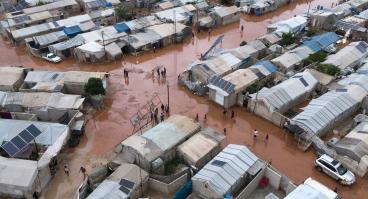Measuring Female Labor Force Participation in the GCC

Table of Contents
Author(s)
Gail Buttorff
Former Contributing ExpertBozena Welborne
Former Contributing ExpertNawra al-Lawati
Lecturer, Sultan Qaboos UniversityShare this Publication
- Download PDF
- Print This Publication
- Cite This Publication Copy Citation
Buttorff, Gail, Bozena Welborne, and Nawra al-Lawati. Measuring Female Labor Force Participation in the GCC. 2018. Issue brief no. 01.18.18. Rice University’s Baker Institute for Public Policy, Houston, Texas.
Introduction
In recent years, the Middle East and North Africa (MENA) region has experienced significant societal changes, both good and bad, from the hopes of the Arab Spring to the humanitarian winter of the Syrian crisis. While the security issues and conflicts plaguing the region have been obsessively chronicled in the media, subtle shifts in the socioeconomic profile of the MENA region have attracted much less attention, but are nonetheless equally important.
In particular, the Gulf Cooperation Council (GCC) states—Bahrain, Kuwait, Oman, Qatar, Saudi Arabia, and the United Arab Emirates (UAE)—are beginning to witness important shifts in their respective societies that transcend the typical focus on the destabilizing youth bulge so often trotted out in analyses of the region. One such shift is the increasing presence of women in the professional workforce. Generally, Arab women have been slow to enter the formal labor force across the MENA region over the past 50 years, facing significant cultural and institutional setbacks. However, women in the GCC seem to have leapfrogged job opportunities in low-paying and low-skilled manufacturing industries typical for women in North Africa and the Levant to find employment in high-level service sector professions. Essentially, they have become regional outliers, but not because they are marginalized from the workforce as suggested in extant scholarly works.1 Rather, we see higher levels on average of female citizen labor force participation in the GCC than in North Africa or the Levant, despite a very traditional culture most exemplified by the GCC’s conservative guardianship laws and family code.
This brief explores how a quirk in the measurement of women’s labor force2 participation and the demographic peculiarities of the Persian Gulf have resulted in the significant undercounting of female citizen labor by pundits and scholars alike. The GCC states fall short of the MENA regional average when it comes to the participation of women as a percentage of the total labor force, which includes both men and women aged 15 years and older, as well as citizens and noncitizens. However, measuring female economic participation in this way may not accurately reflect the true presence of women in the domestic workforce because of the large share of noncitizen male labor in the GCC, which overwhelms employment statistics for women overall and female citizens in particular. An alternative measure, using female population in the denominator rather than total labor force, eliminates distortions in the female labor participation rate caused by extreme demographic imbalances in Gulf countries’ labor forces and populations; in so doing, it provides a clearer picture of women’s economic participation in the oil-rich economies of the MENA region.
A Tale of Two Statistics
Simply put, women are quickly becoming the next generation of GCC working professionals, and female citizens are already an important part of the workforce. As can be seen in Table 1, GCC countries stand out among their Arab counterparts in hosting some of the highest female labor force participation rates in the MENA region, where women comprise only about a quarter of the labor force on average. Countries such as Kuwait and Qatar even have women participating in the workforce at rates on par with the West, when we account for women working as a percentage of the female population aged 15 years and older (Table 1, Column B). Some argue that these higher labor force participation rates in the “extreme rentier” states of Kuwait, Qatar, and the UAE are partially due to higher oil rents per capita. Essentially, these states have a greater ability to reallocate their rents to bolster public sector employment levels across both genders in a bid to accommodate citizen demands and quell potential discontent.4
Such revelations come as a surprise, since most conventional wisdom and a sizable amount of academic scholarship criticizes Arab countries—and the GCC in particular—for marginalizing women from their economic and political spheres. But as we can see in Column B, which demonstrates women’s labor force participation as a percentage of the female population, we can see that GCC countries—with exception of Saudi Arabia—are actually fairly competitive with some of their EU counterparts or even outpace them, as in the case of Italy.
Table 1 — Women in the Workforce (2012)
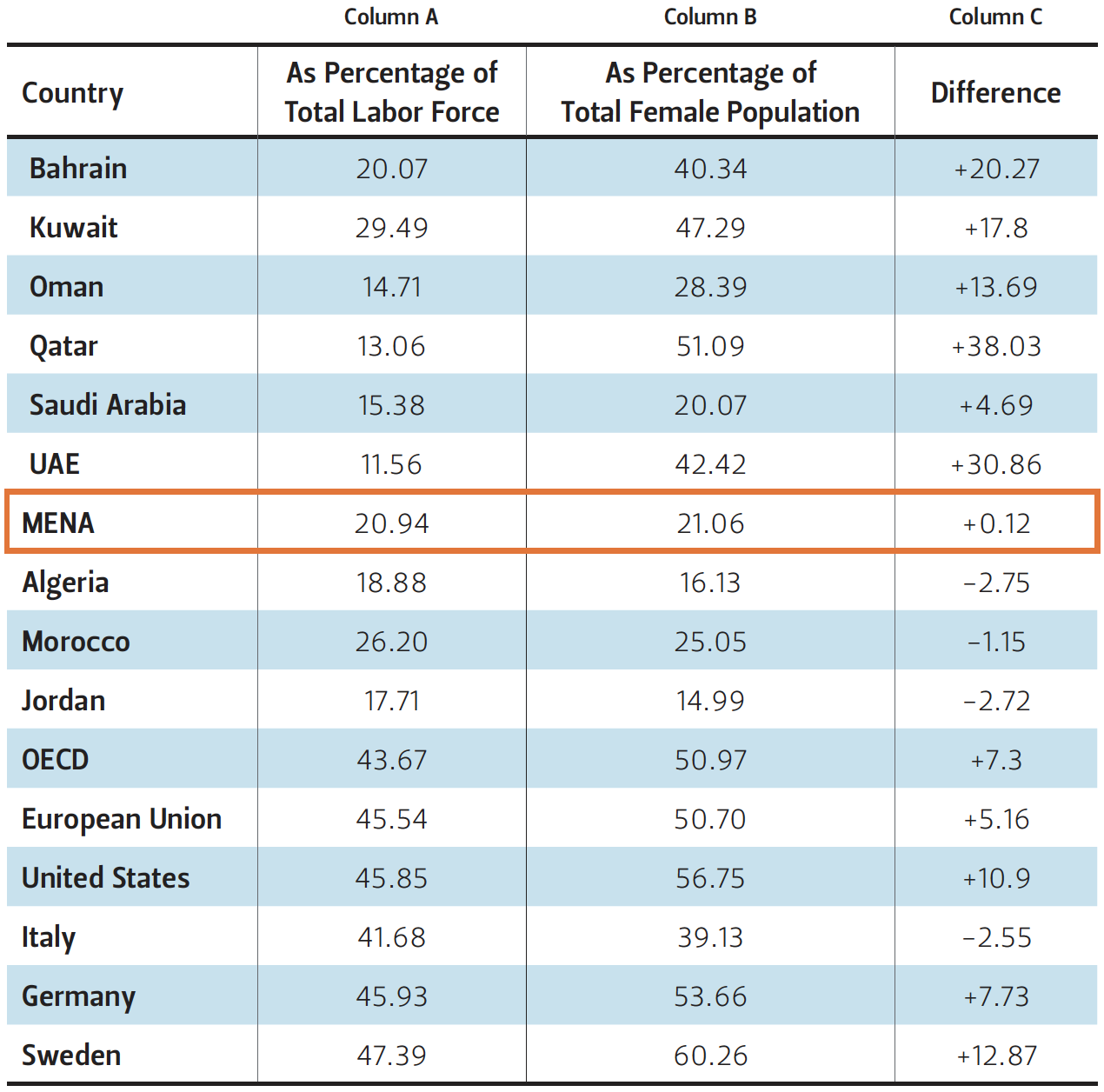
Figure 1 plots the two national level labor force participation statistics shown in Table 1 for all MENA countries in 2012. The first indicator, plotted on the x-axis, is the standard labor force indicator: women in the labor force as a percentage of the total labor force (Table 1, Column A). Plotted on the y-axis is women in the labor force as a percentage of the female population (Table 1, Column B). Two observations stand out: First, most countries fall on or close to the orange 45-degree line, meaning the two statistics have roughly equal values. For example, Jordan (JOR)—found in the cluster of countries above Syria (SYR) and below the West Bank and Gaza (WBG)—has a value of 17.71 percent for the first indicator (Column A) and 14.99 percent for the second (Column B). Similarly, Morocco (MOR)—which lies below the orange line in the cluster of countries above Egypt (EGY) and Lebanon (LBN)—has a value for the first statistic of 26.20 percent and 25.05 percent for the second.
Figure 1 — Two Measures of Women’s Labor Force Participation in the MENA Region (2012)
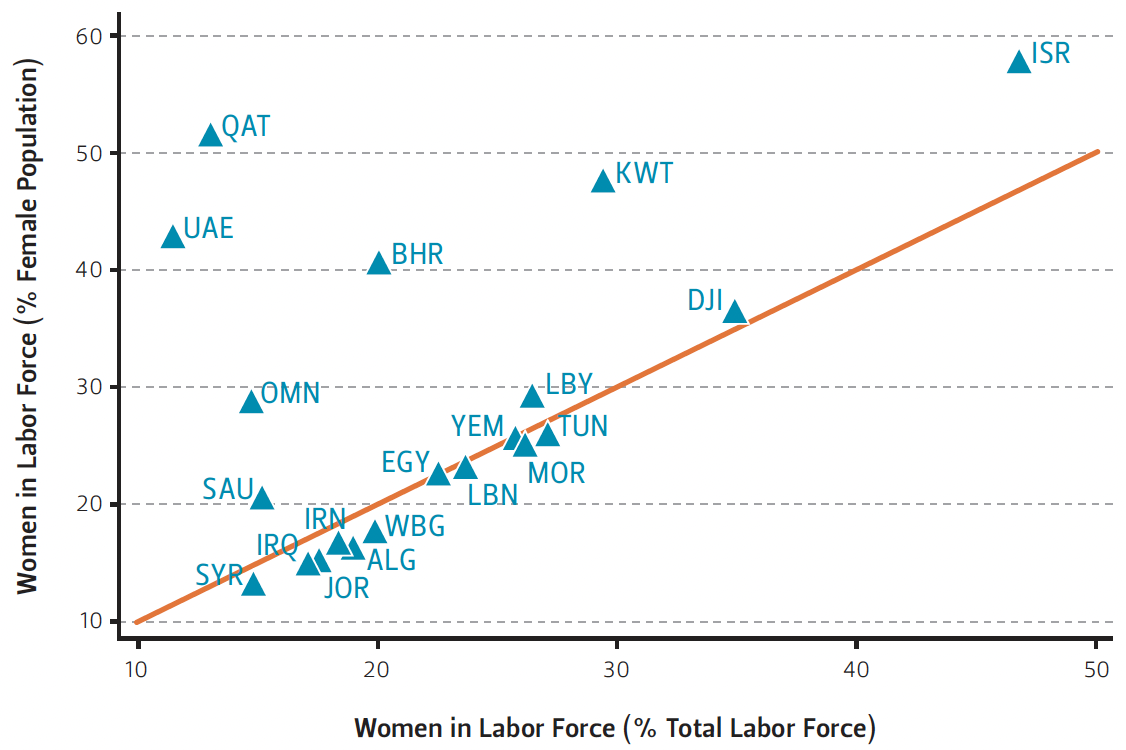
The second observation is that the largest differences between the two indicators are found in the GCC—all six countries are located above the 45-degree line. For example, consider the UAE, where the difference between the two statistics is 30.86, compared to only 1.15 for Morocco and 2.72 for Jordan. Strikingly, from the data in Table 1 we can see that for Oman and Kuwait, the statistic for women’s labor force participation as a percentage of the female population (Column B) is approximately double the value for women’s workforce participation as a percentage of the total labor force; and in Qatar and the UAE, the indicator in Column B is more than 3.5 times larger than that of Column A. We do not encounter such a wide divide between these statisitcs for other nations, which directly points to the unique demographic context of the GCC states.
Figure 2 — Citizen Versus Noncitizen Labor Distribution in the GCC as a Percentage of Total Labor Force
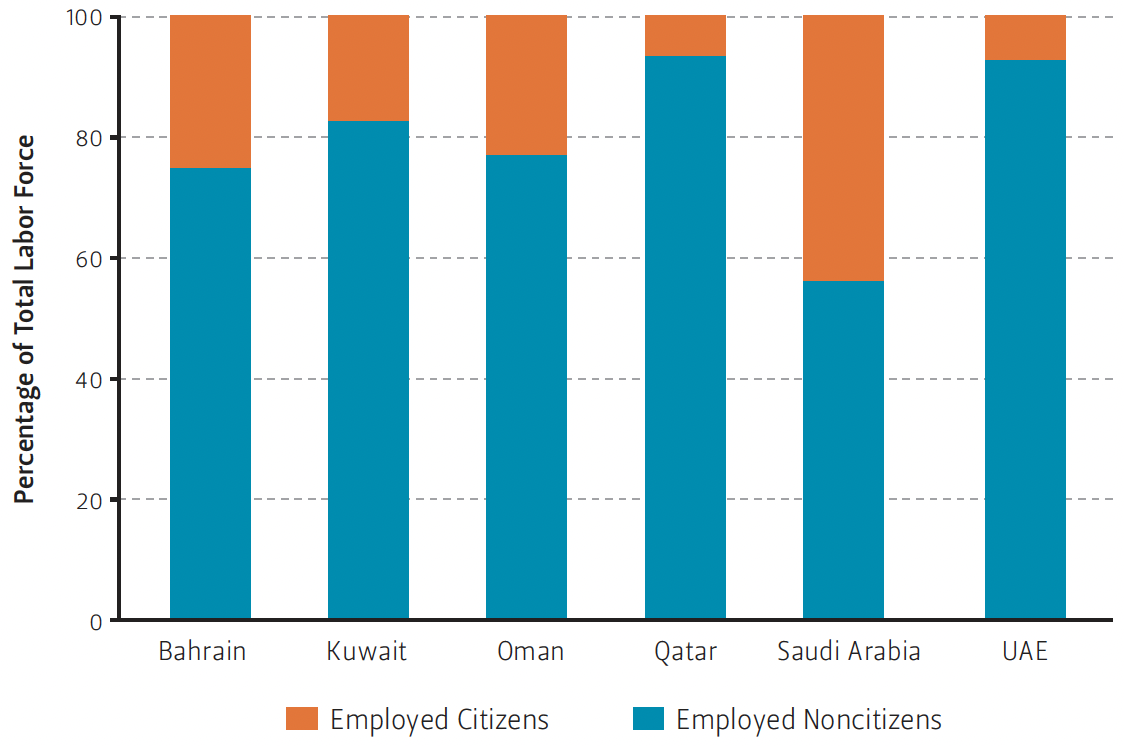
With the exceptions of Israel (ISR) and Djibouti (DJI), all of the countries above the orange line in Figure 1 are oil producers. Oil, however, is not a sufficient explanation, as exceptions to the pattern of oil wealth include countries like Algeria (ALG) and Iraq (IRQ), which are oil-rich and fall below the red line. Apart from oil, a factor uniting all of the Arab countries above the line (including Libya) is a reliance on imported labor. This would also account for Algeria and Iraq, which have large populations relative to the GCC states—effectively hosting a labor surplus in contrast to to the GCC’s labor shortage. Moreover, Algeria is a net exporter of labor to Europe. In contrast, most GCC states have to import both blue- and white-collar labor from abroad to satisfy market demand. Saudi Arabia (SAU), with its 32 million people, is the sole exception to this pattern (see Figure 2).
In fact, the majority of the population living in the GCC is made up of expatriates; on average, 60 percent or more of the labor force consists of noncitizens.5 Figure 2 reflects the differences in the composition of the labor force across GCC countries, with citizen labor making up an average of 20.3 percent, compared to the 79.7 percent composed of non-nationals. This demographic imbalance is highest in Qatar and the UAE, with non-nationals making up nearly 95 percent of the workforce, and the lowest in Saudi Arabia, where non-nationals are approximately 50 percent of the workforce.6 In most of the remaining MENA countries, we do not observe such a significant demographic imbalance in either the labor force or the population at large.
GCC countries continue to be heavily dependent on migrant labor—particularly in the private sector, where foreign workers far outnumber national employees. Importantly, the likelihood of this demographic peculiarity changing is slim, since GCC countries do not provide a legal basis for naturalization. Thus, these foreign laborers will always be considered temporary migrants rather than immigrants.7
Another important aspect of the GCC states’ labor markets is not just the overwhelming number of expatriates in the workforce, but also the sheer number of men represented in that group.8 Figure 3 illustrates the significant demographic imbalance in the ratio of males to females across the GCC. Given the fact that a large proportion of the labor force in GCC countries is foreign and the fact that the migrant labor population skews heavily male, this can obscure the true participation rate of women, making it seem to be lower than it actually is. In other words, the male component of the labor force—both citizen and noncitizen—overshadows the contribution of women to the labor force, making their participation look comparatively low relative to other MENA states, whose overall labor force is largely composed of citizens. In GCC countries and other states that host a significant number of noncitizen workers, the first measure—the x-axis in Figure 1 and Column A in Table 1—fails to take into account the demographic imbalance in both the population and the workforce.
Figure 3 — Number of Men per 100 Women in the GCC
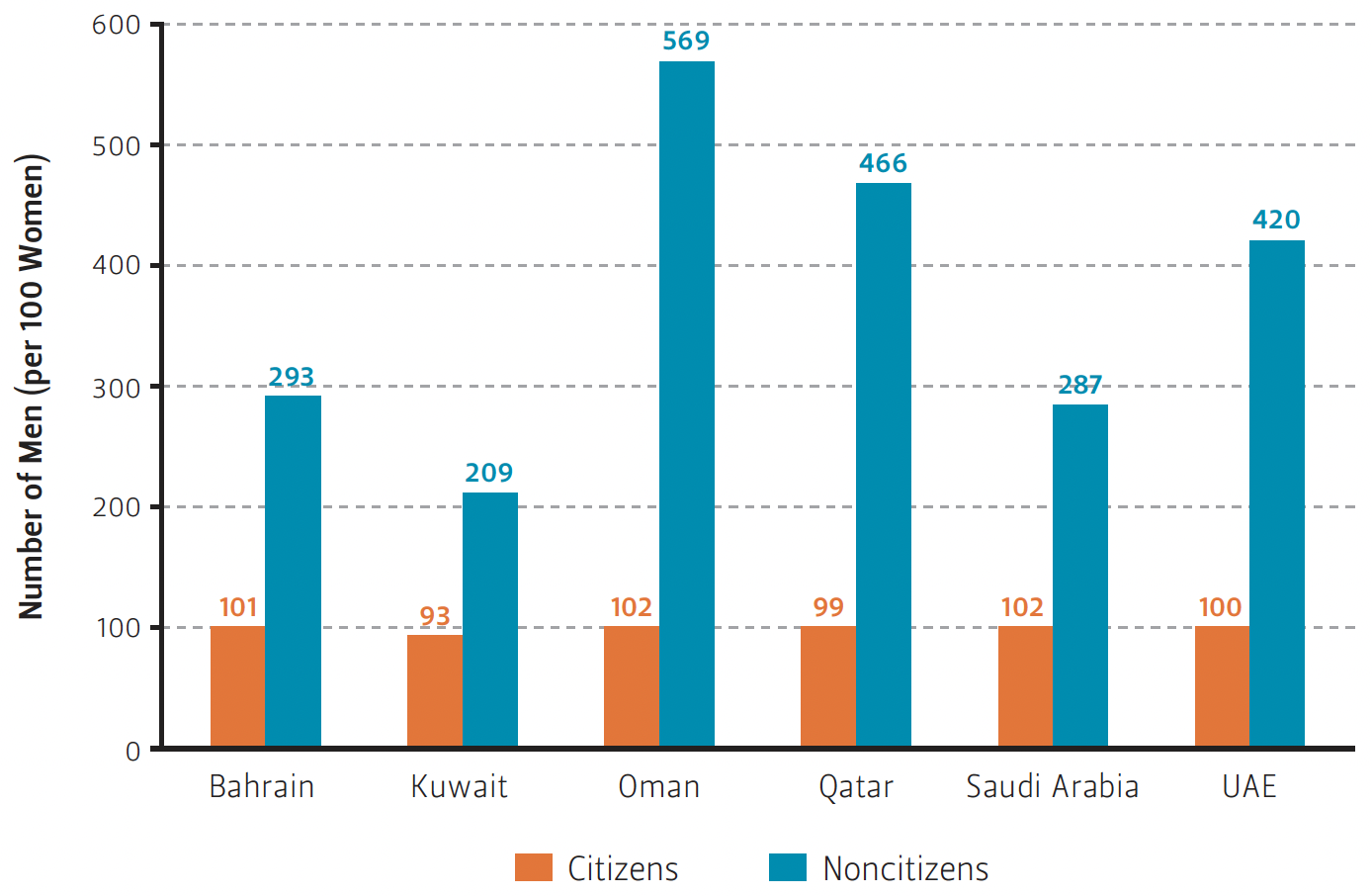
When only the female population is examined, GCC women fare relatively well in comparison to their male counterparts in terms of employment. For example, Qatar demonstrates a female labor force participation rate of only 13 percent of the total workforce; however, when the female population participation rate is examined, we find that 50 percent of Qatari female citizens are in fact working (see Table 1). We see similar trends in Bahrain, where a large proportion of the female population works, but it appears that women make up only a small proportion of the total labor force—again, due to the overwhelming presence of largely male noncitizens in the labor force. In fact, Bahrain, Oman, Qatar, and Kuwait are clear outliers in the region, together with Israel, Djibouti, and Libya, in terms of the percentage of the female population that works (see also Figure 1). As mentioned previously, Libya is also a labor importer and thus an outlier in North Africa, a region of labor exporters. Israel and Djibouti reflect the labor force trends of the regions they are linked to in the minds of the rest of the world: Israel is usually grouped with Europe, while Djibouti draws comparison to the rest of sub-Saharan Africa.9 This showcases how significant foreign labor can be in skewing assessments of women’s presence in the workforce, and the need to be cognizant of how global interdependence and labor migration are dramatically changing how we employ and interpret what were formerly considered “conventional” statistics.10
Implications for Future Research and Policy
Based on this analysis, the GCC states are not laggards when it comes to women’s inclusion in the workforce, as is often hypothesized. In a forthcoming study, we argue that this is a byproduct of labor nationalization policies adopted in the late 20th century, which mobilized both male and female citizens into the workforce.11 Yet where does this leave women on the political front? Surprisingly, given their gains in the economic sphere, women still lag far behind in the political realm. Qatar has yet to see a woman in its legislative assembly, and women are still rarely directly elected to national legislatures across the Arabian peninsula. Usually, they obtain political office through appointment. However, this may yet change with their increasing clout in the workforce.
In fact, the growing overtures made by GCC regimes toward their female citizens may be emblematic of this, as GCC women are increasingly cast as the “regional bulwark” against fears of a demographic imbalance vis-a-vis expat labor, as well as the protectors of “national identity.” Furthermore, women are also being embraced as a sign of the GCC’s “modernity,” in conjunction with new gender mainstreaming measures adopted by a number of states.12 Is this a strategy to pacify women, or one aimed at gradually including them into the political infrastructure of the state? It is difficult to say, since many would argue that neither male nor female citizens have much say in the actual politics of the GCC monarchies, although these states spend a lot of money keeping their citizens happy by providing direct subsidies for housing and extremely generous maternal benefits—especially in the aftermath of the Arab Spring.13
The demographic peculiarity of the GCC also serves to highlight the increasing interdependence of the world due to labor flows conditioned by labor shortages and surpluses across varying states. In the case of the GCC nations, the resulting demographic shifts may eventually have unintended political ramifications.14 But for now, the fear of dependence on “the other” appears to have resulted in economic opportunities for their “own” women.
Endnotes
1. See Michael L. Ross, “Oil, Islam, and Women,” American Political Science Review 102, no. 1 (2008): 107-23; or Yu-Ming Liou and Paul Musgrave, “Oil, Autocratic Survival, and the Gendered Resource Curse: When Inefficient Policy Is Politically Expedient,” International Studies Quarterly 60, no. 3 (2016): 440-56.
2. Per the International Labour Organization, “The labour force is the sum of persons in employment plus persons in unemployment. Together these two groups of the population represent the current supply of labour for the production of goods and services taking place in a country through market transactions in exchange for remuneration.” See http://www.ilo.org/global/statistics-and-databases/statistics-overview-and-topics/WCMS_470304/lang--en/index.htm.
3. World Bank. World Development Indicators 2012 (Washington, D.C.: World Bank, 2012), http://databank.worldbank.org/data/reports.aspx?source=world-development-indicators. Both labor force statistics are based on International Labour Organization estimates of participation rates.
4. Michael Herb, The Wages of Oil: Parliaments and Economic Development in Kuwait and the UAE (Ithaca, New York: Cornell University Press, 2014); Gail Buttorff and Bozena Welborne, Rethinking Economic Rentierism and Women’s Empowerment (issue brief no. 09.25.15, Rice University’s Baker Institute for Public Policy, Houston, Texas, September 2015).
5. Laura L. Matherly and Sasha Hodgson, “Implementing Employment Quotas to Develop Human Resource Capital: A Comparison of Oman and the UAE,” International Journal of Liberal Arts and Social Science 2, no. 7 (2014): 75-90; Kasim Randeree, “Workforce Nationalization in the Gulf Cooperation Council States” (occasional paper no. 9, Center for International and Regional Studies, Georgetown University School of Foreign Service in Qatar, Doha, Qatar, 2012); Steffen Hertog, “A comparative assessment of labor market nationalization policies in the GCC,” in National Employment, Migration and Education in the GCC, ed. Steffen Hertog (Berlin: Gerlach Press, 2012), 100-2.
6. Ingo Forstenlechner and Emilie Rutledge, “The GCC’s ‘Demographic Imbalance’: Perceptions, Realities and Policy Options,” Middle East Policy 18, no. 4 (2011): 25-43. Per the author’s calculations, the percentage of non-nationals in the workforce in 2010 in each of the GCC nations are: the UAE—95.8 percent; Qatar—94.3 percent; Kuwait—83.1 percent; Oman—71.3 percent; Bahrain—63.9 percent; and Saudi Arabia—49.5 percent.
7. Forstenlechner and Rutledge, 2.
8. George Naufal and Ismail Genc, “Labor Migration in the GCC Countries: Past, Present and Future” (Singapore Middle East Papers no. 9/2), June 2, 2014, https://mei.nus.edu.sg/wp-content/uploads/2014/06/SMEP-9-2-Naufal-Genc.pdf.
9. The average regional women’s labor force participation rate as a percentage of total workforce in sub-Saharan Africa in 2016 was 45.8 percent, surprisingly about the same level as much of the European Union. The regional statistic for women’s labor force participation as a percentage of the overall female population was 62.8 percent for sub-Saharan Africa and 51 percent for the European Union (World Development Indicators 2016).
10. Naufal and Genc, “Labor Migration.”
11. Gail Buttorff, Nawra al-Lawati, and Bozena Welborne, “Cursed No More? The Resource Curse, Gender, and Labor Nationalization Policies in the GCC” (forthcoming).
12. Caline Malek, “Gender Equality in the UAE Ranked Best in the GCC Region,” The National, October 26, 2013, https://www.thenational.ae/uae/education/gender-equality-in-the-uae-ranked-best-in-gcc-region-1.344233. See also Tari Ellis, Chiara Marcati, and Julia M. Sperling, “Promoting Gender Diversity in the Gulf,” February 2015, https://www.mckinsey.com/business-functions/organization/our-insights/promoting-gender-diversity-in-the-gulf.
13. “Throwing money at the street,” The Economist, March 10, 2011, http://www.economist.com/node/18332638.
14. Paul Collier, Exodus: Immigration and Multiculturalism in the 21st Century (London: Penguin Books, 2014).
This material may be quoted or reproduced without prior permission, provided appropriate credit is given to the author and Rice University’s Baker Institute for Public Policy. The views expressed herein are those of the individual author(s), and do not necessarily represent the views of Rice University’s Baker Institute for Public Policy.


